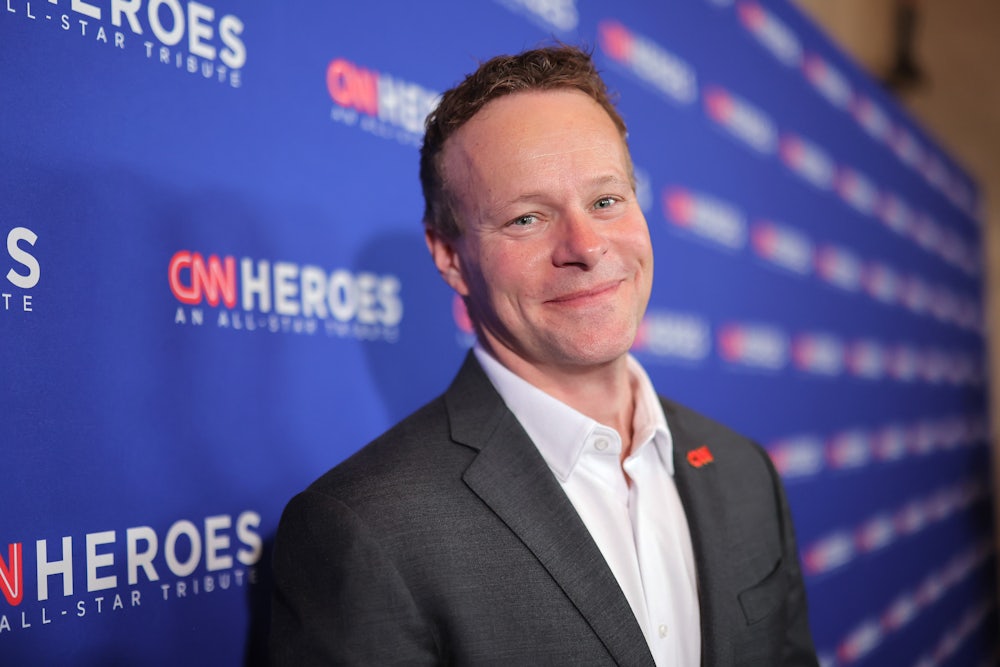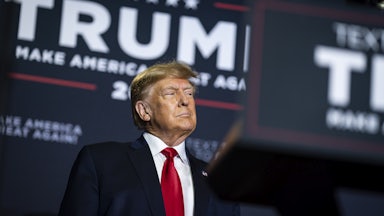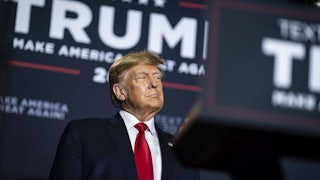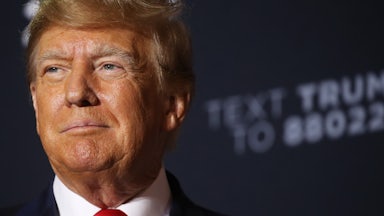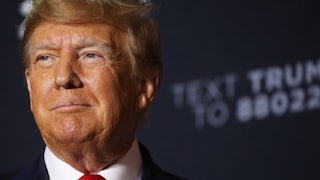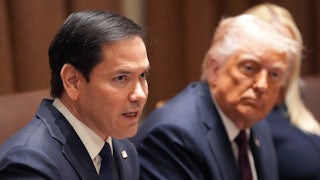CNN’s brass defended its disastrous early-May town hall with Donald Trump on journalistic grounds, arguing that while he may present unique challenges as an interview subject—serial lying, general incoherence, a literal attempted coup—it was ultimately better to hear from the front-runner for the Republican Party’s 2024 presidential nomination than to ignore him. “We obviously can’t control what Donald Trump says—that’s up to him,” the network’s news director, David Chalian, told Vanity Fair a week before the event. “What we can do is prod, ask questions, follow up, and try to get as revealing answers as possible.”
This scenario, we know with the gift of hindsight (and, to be fair, the gift of foresight as well, as this was all eminently predictable), was not what transpired during the chaotic town hall. Moderator Kaitlan Collins made a game effort to rein Donald Trump in, but as usual, he simply steamrolled over her while an audience packed to the gills with supporters hooted and hollered in support.
Many at CNN suspected this would happen because they had all lived through 2016 and knew the score through hard-earned experience. “It’s hard to see how America was served by the spectacle of lies that aired on CNN Wednesday evening,” wrote the network’s media reporter, Oliver Darcy, soon after, as he recounted the litany of lies told by the former president. “And CNN aired it all. On and on it went. It felt like 2016 all over again. It was Trump’s unhinged social media feed brought to life on stage.” Perhaps CNN’s leaders are new at this and didn’t know how it would play out; perhaps they were fully aware this is what would happen, and they allowed it to play out anyway. Either way you slice it, they don’t come out looking good.
But if you put yourself in the shoes of a cable news executive (brain full of worms, conscience fully in “bad for America but incredible content” mode), you might be able to imagine a twisted vision in which this town hall was a win-win. For one thing, by holding the town hall, CNN was unofficially kicking off presidential primary season. Elections mean ratings boosts, and no one has ever boosted ratings quite like Donald Trump—sure, he might be a threat to the republic and the institution of journalism itself, but he always brought fireworks and eyeballs.
But another factor in play is the fact that CNN was in the midst of a significant rebrand. Under new CEO Chris Licht, the network was attempting to establish itself as a neutral, nonpartisan space—and (theoretically) hoover up viewers who were repulsed by the increasingly ugly partisan politics on display at rivals MSNBC and Fox News. The network wanted to win back independent viewers (whoever they are)—and woo the conservatives and right-wingers who had soured on it during the Trump years. And what better way to demonstrate that it’s a new day at CNN than by hosting Trump himself?
Well, none of these well-laid plans worked. The town hall was a hilarious and predictable journalistic and political disaster that brought CNN mockery on the day of the event. But now that some time has passed, we’ve learned that it was a business failure as well: A paltry 3.1 million viewers tuned in.
This shouldn’t have been a surprise—Trump simply does not have the drawing power he once had, and a sizable portion of the public is clearly sick of him. But there appears to have been a rather serious knock-on effect of broadcasting the town hall. In the weeks after the former president appeared on CNN, the network’s ratings have plummeted. In fact, its ratings last week were the worst the network has posted since June 2015—a momentous month in American politics, given Trump’s now infamous escalator ride. The network averaged just 429,000 total daily viewers from Monday to Friday, per data cited to The Daily Beast—less than half of those of MSNBC and Fox News.
This is a catastrophe on every level. It’s also a repudiation of the shifts Licht has tried to oversee at CNN. The generous take of his vision is that he’s tried to make the network a home for people who are sick of the combative and shrill partisan politics that define American politics—a place for normal people, disaffected people, and people who are both normal and disaffected, not just those who are eagerly cheering for team red or team blue. (Why these people wouldn’t just watch Ted Lasso instead of the news is something no one seems to have considered, though judging by this season of Ted Lasso, I’m not sure why anyone would keep tuning in, normal or otherwise.)
But it’s hard to square courting a weird audience of neutral and dispassionate news consumers while simultaneously doing what cable news does best—gin up cheap conflict, create bombastic moments out of nothing, generally exacerbate every single division in America today. The ungenerous take is that Licht simply hoped that he could make a few blood sacrifices to the right and—voilà—he’d have the audience that CNN has always aspired to, made up of equal numbers of Democrats and Republicans; finally wrestle the platonic ideal of a cable news audience into existence. That’s even harder to do—as CNN’s own recent history has shown.
During the 2016 election and in the early days of the Trump administration, the network did everything it possibly could to try to woo Trump voters. It brought Trump supporters on its panels, even though these people were typically as honest and well balanced as Trump himself. The network ultimately bailed on this approach after a number of these walking liabilities to journalism crashed and burned—prompting the late-in-arriving realization that one could not simultaneously pretend to be a news network (even a cable news network) and have people spouting obvious lies and propaganda at every moment. Trump’s entire approach to politics involves disregarding basic reality; this is an obvious problem for news outlets. It’s one that Licht forgot. Now he and CNN are paying the price.
